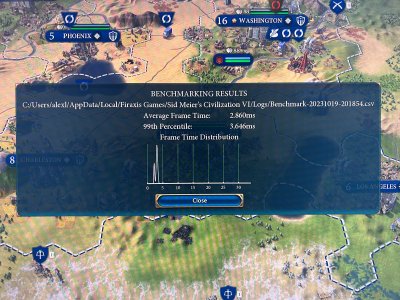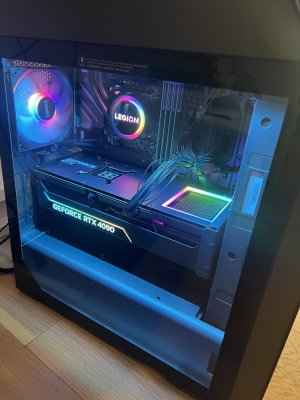I have some rather unusual benchmarks that people may find interesting.
I recently built an old disused dual socket server motherboard into a workstation. It had two 12C/24T Xeon E5-2697 V2 (Ivy bridge era) CPU's in it. They are ancient now, but take a look at these results:
| CPU | Vanilla Civ 6 End of Turn Benchmark Time | Gathering Storm End of Turn Benchmark Time |
| Sandy Bridge-E, 6C/12T, 4.7Ghz OC | 16.76s | N/A* |
| 2x Ivy Bridge Xeon E5-2697 V2 24C/48T total at 2.7Ghz base, max turbo of 3.5Ghz | 8.47s | 48.46 |
| Threadripper 3960x (Zen2, 24C/48T, 3.8Ghz base 4.5Ghz max turbo) | 6.72s | 31.61s |
*Sadly I didn't have this CPU installed in any system that could run the game once Gathering Storm came out, so I never tested it.
The comparison is interesting.
The first system was highly overclocked. It never throttled, and ran at 4.7Ghz on all cores.
The second system is Ivy bridge, which means a maybe ~3% IPC improvement, but at the same time the core clocks are much MUCH lower. (anywhere from 57% to 74% of the top systems clock depending on turbo level. I forgot to check what it was actually clocking at in this test, but in less threaded loads (Like TimeSpy) it has no problem pinning itself at 3.5Ghz, at least in low threaded workloads.
The Threadripper of course shreds everything else, as - despite it being 5 years old now, compared to the other CPU's it has both high core count and best per thread performance of the three.
But the interesting part is the comparison between the Sandy bridge chip and the Ivy Bridge server.
If Civ6 couldn't take advantage of threading above 6C/12T, the server chips should lose badly. The per thread performance, once IPC improvements are factored in is only 59% to 75% of the per thread performance of the sandy chip, and it also uses registered ECC RAM which is slower. It does have a boatload of RAM (256GB) but the Sandy system also had a decent amount (64GB) so I doubt that made much of a difference.
So the fact that it has many cores was able to not just make up for its much lower per core performance, but also allowed it to surpass the Sandy chip, coming within a hair of doubling its performance.
That is actually pretty cool, and illustrates that while Civ6 maybe doesn't
quite take advantage of all the cores, it can definitely scale with core counts well above typical desktop levels.
I'm actually amused at how well this over a decade old server board actually handles both Civ5 and Civ6.
Civ5 shouldn't be a surprise. It had already been on the market for 3 years when both this Xeon and the 6GB Titan were launched in 2013. It handles them admirably.
In typical heavy late game scenarios, I get ~80-90fps in Civ 5.
In Civ 6, it only musters ~48fps in heavy late game scenes, but this is Civ. Civ is playable even at 15fps. And honestly, the heavy late game benchmark is kind of extreme. It definitely does 60fps in early game, and probably manages to do so most of a playthrough.
I only have it hooked up to an old low resolution 1680x1050 HP monitor I pulled out of a recycling bin on the loading dock at work a decade ago, so it isn't exactly challenging the titan with high resolution gaming, but still. The fact that this aging hulk of a server board and my old Titan does even this well, is actually pretty amusing.
So, anyway, long story short. Yes. Civ6 benefits from thread count.




